Killer whale
The orca or killer whale (Orcinus orca) is a toothed whale belonging to the oceanic dolphin family, of which it is the largest member. Killer whales have a diverse diet, although individual populations often specialize in particular types of prey. Some feed exclusively on fish, while others hunt marine mammals such as seals and other species of dolphin. They have been known to attack baleen whale calves, and even adult whales. Killer whales are apex predators, as no animal preys on them. A cosmopolitan species, they can be found in each of the world's oceans in a variety of marine environments, from Arctic and Antarctic regions to tropical seas, absent only from the Baltic and Black seas, and some areas of the Arctic Ocean.
| Killer whale[1] Orca | |
|---|---|
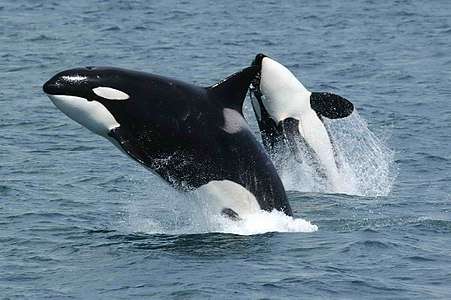 | |
 | |
Size compared to a 1.80-metre (5 ft 11 in) human | |
| Scientific classification | |
| Kingdom: | Animalia |
| Phylum: | Chordata |
| Class: | Mammalia |
| Order: | Artiodactyla |
| Infraorder: | Cetacea |
| Family: | Delphinidae |
| Genus: | Orcinus Fitzinger, 1860[4] |
| Species: | O. orca |
| Binomial name | |
| Orcinus orca | |
 | |
| Orcinus orca range | |
| Synonyms | |
| |
Killer whales are highly social; some populations are composed of matrilineal family groups (pods) which are the most stable of any animal species. Their sophisticated hunting techniques and vocal behaviours, which are often specific to a particular group and passed across generations, have been described as manifestations of animal culture.
The International Union for Conservation of Nature assesses the orca's conservation status as data deficient because of the likelihood that two or more killer whale types are separate species. Some local populations are considered threatened or endangered due to prey depletion, habitat loss, pollution (by PCBs), capture for marine mammal parks, and conflicts with human fisheries. In late 2005, the southern resident killer whales, which swim in British Columbia and Washington state waters, were placed on the U.S. Endangered Species list.
Wild killer whales are not considered a threat to humans and no fatal attack on humans has ever been documented, but there have been cases of captive orcas killing or injuring their handlers at marine theme parks. Killer whales feature strongly in the mythologies of indigenous cultures, and their reputation in different cultures ranges from being the souls of humans to merciless killers.
Taxonomy and evolution
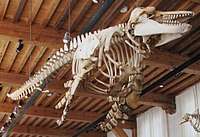
Orcinus orca is the only recognized extant species in the genus Orcinus, and one of many animal species originally described by Carl Linnaeus in his landmark 1758 10th edition of Systema Naturae.[6] Konrad Gessner wrote the first scientific description of a killer whale in his Piscium & aquatilium animantium natura of 1558, part of the larger Historia animalium, based on examination of a dead stranded animal in the Bay of Greifswald that had attracted a great deal of local interest.[7]
The killer whale is one of 35 species in the oceanic dolphin family, which first appeared about 11 million years ago. The killer whale lineage probably branched off shortly thereafter.[8] Although it has morphological similarities with the false killer whale, the pygmy killer whale and the pilot whales, a study of cytochrome b gene sequences by Richard LeDuc indicated that its closest extant relatives are the snubfin dolphins of the genus Orcaella.[9] However, a more recent (2018) study places the orca as a sister taxon to the Lissodelphininae, a clade that includes Lagenorhynchus and Cephalorhynchus.[10]
Common names
Although the term "orca" is increasingly used, English-speaking scientists most often use the traditional name "killer whale".[11] The genus name Orcinus means "of the kingdom of the dead",[12] or "belonging to Orcus".[13] Ancient Romans originally used orca (pl. orcae) for these animals, possibly borrowing Ancient Greek ὄρυξ (óryx), which referred (among other things) to a whale species. Since the 1960s, "orca" has steadily grown in common use.[11] As part of the family Delphinidae, the species is more closely related to other oceanic dolphins than to other whales.[14]
They are sometimes referred to as "blackfish", a name also used for other whale species. "Grampus" is a former name for the species, but is now seldom used. This meaning of "grampus" should not be confused with the genus Grampus, whose only member is Risso's dolphin.[15]
Types
The three to five types of killer whales may be distinct enough to be considered different races,[16] subspecies, or possibly even species[17] (see Species problem). The IUCN reported in 2008, "The taxonomy of this genus is clearly in need of review, and it is likely that O. orca will be split into a number of different species or at least subspecies over the next few years."[3] Although large variation in the ecological distinctiveness of different killer whale groups complicate simple differentiation into types,[18] research off the west coast of Canada and the United States in the 1970s and 1980s identified the following three types:
- Resident: These are the most commonly sighted of the three populations in the coastal waters of the northeast Pacific. Residents' diets consist primarily of fish[19] and sometimes squid, and they live in complex and cohesive family groups called pods.[20] Female residents characteristically have rounded dorsal fin tips that terminate in a sharp corner.[21] They visit the same areas consistently. British Columbia and Washington resident populations are amongst the most intensively studied marine mammals anywhere in the world. Researchers have identified and named over 300 killer whales over the past 30 years.[22]
- Transient: The diets of these whales consist almost exclusively of marine mammals.[19][21] Transients generally travel in small groups, usually of two to six animals, and have less persistent family bonds than residents.[23] Transients vocalize in less variable and less complex dialects.[24] Female transients are characterized by more triangular and pointed dorsal fins than those of residents.[21] The grey or white area around the dorsal fin, known as the "saddle patch", often contains some black colouring in residents. However, the saddle patches of transients are solid and uniformly grey.[21] Transients roam widely along the coast; some individuals have been sighted in both southern Alaska and California.[25] Transients are also referred to as Bigg's killer whale in honour of cetologist Michael Bigg. The term has become increasingly common and may eventually replace the transient label.[26]
- Offshore: A third population of killer whales in the northeast Pacific was discovered in 1988, when a humpback whale researcher observed them in open water. As their name suggests, they travel far from shore and feed primarily on schooling fish.[27] However, because they have large, scarred and nicked dorsal fins resembling those of mammal-hunting transients, it may be that they also eat mammals and sharks.[28][29] They have mostly been encountered off the west coast of Vancouver Island and near Haida Gwaii. Offshores typically congregate in groups of 20–75, with occasional sightings of larger groups of up to 200.[30] Little is known about their habits, but they are genetically distinct from residents and transients. Offshores appear to be smaller than the others, and females are characterized by dorsal fin tips that are continuously rounded.[21]
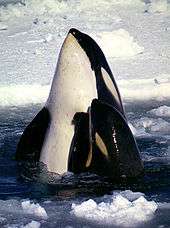
Transients and residents live in the same areas, but avoid each other.[31][32][33]
Other populations have not been as well studied, although specialized fish and mammal eating killer whales have been distinguished elsewhere.[34] In addition, separate populations of "generalist" (fish- and mammal-eating) and "specialist" (mammal-eating) killer whales have been identified off northwestern Europe.[35][36] As with residents and transients, the lifestyle of these whales appears to reflect their diet; fish-eating killer whales in Alaska[37] and Norway[38] have resident-like social structures, while mammal-eating killer whales in Argentina and the Crozet Islands behave more like transients.[39]
Three types have been documented in the Antarctic. Two dwarf species, named Orcinus nanus and Orcinus glacialis, were described during the 1980s by Soviet researchers, but most cetacean researchers are sceptical about their status, and linking these directly to the types described below is difficult.[17]
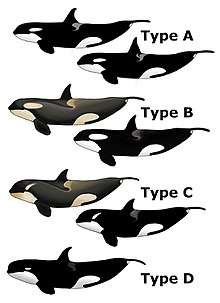
- Type A looks like a "typical" killer whale, a large, black-and-white form with a medium-sized white eye patch, living in open water and feeding mostly on minke whales.[17]
- Type B is smaller than type A. It has a large white eye patch. Most of the dark parts of its body are medium grey instead of black, although it has a dark grey patch called a "dorsal cape"[40] stretching back from its forehead to just behind its dorsal fin. The white areas are stained slightly yellow. It feeds mostly on seals.[17]
- Type C is the smallest and lives in larger groups than the others. Its eye patch is distinctively slanted forwards, rather than parallel to the body axis. Like type B, it is primarily white and medium grey, with a dark grey dorsal cape and yellow-tinged patches. Its only observed prey is the Antarctic cod.[17]
- Type D was identified based on photographs of a 1955 mass stranding in New Zealand and six at-sea sightings since 2004. The first video record of this type was made in 2014 between the Kerguelen and Crozet Islands,[41] and again in 2017 off the coast of Cape Horn, Chile.[42] It is recognizable by its small white eye patch, narrower and shorter than usual dorsal fin, bulbous head (similar to a pilot whale), and smaller teeth.[43] Its geographic range appears to be circumglobal in sub-Antarctic waters between latitudes 40°S and 60°S. Although its diet is not determined, it likely includes fish, as determined by photographs around longline vessels, where Type D orcas appeared to be preying on Patagonian toothfish (Dissostichus eleginoides).[44][45]
Types B and C live close to the ice pack, and diatoms in these waters may be responsible for the yellowish colouring of both types.[17][46] Mitochondrial DNA sequences support the theory that these are recently diverged separate species.[47] More recently, complete mitochondrial sequencing indicates the two Antarctic groups that eat seals and fish should be recognized as distinct species, as should the North Pacific transients, leaving the others as subspecies pending additional data.[48] Advanced methods that sequenced the entire mitochondrial genome revealed systematic differences in DNA between different populations.[49] A 2019 study of Type D orcas also found them to be distinct from other populations and possibly even a unique species.[44]
Mammal-eating killer whales in different regions were long thought likely to be closely related, but genetic testing has refuted this hypothesis.[50]
There are seven identified ecotypes inhabiting isolated ecological niches. Of three orca ecotypes in the Antarctic, one preys on minke whales, the second on seals and penguins, and the third on fish. Another ecotype lives in the eastern North Atlantic, while the three Northeast Pacific ecotypes are labelled the transient, resident and offshore populations described above. Research has supported a proposal to reclassify the Antarctic seal- and fish-eating populations and the North Pacific transients as a distinct species, leaving the remaining ecotypes as subspecies. The first split in the orca population, between the North Pacific transients and the rest, occurred an estimated 700,000 years ago. Such a designation would mean that each new species becomes subject to separate conservation assessments.[49]
Appearance and morphology
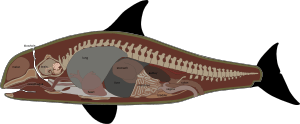
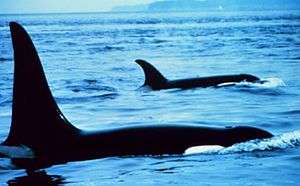
A typical killer whale distinctively bears a black back, white chest and sides, and a white patch above and behind the eye. Calves are born with a yellowish or orange tint, which fades to white. It has a heavy and robust body[51] with a large dorsal fin up to 1.8 m (5 ft 11 in) tall.[52] Behind the fin, it has a dark grey "saddle patch" across the back. Antarctic killer whales may have pale grey to nearly white backs. Adult killer whales are very distinctive, seldom confused with any other sea creature.[53] When seen from a distance, juveniles can be confused with other cetacean species, such as the false killer whale or Risso's dolphin.[54]
The killer whale's teeth are very strong, and its jaws exert a powerful grip; the upper teeth fall into the gaps between the lower teeth when the mouth is closed. The firm middle and back teeth hold prey in place, while the front teeth are inclined slightly forward and outward to protect them from powerful jerking movements.[55]
Killer whales are the largest extant members of the dolphin family. Males typically range from 6 to 8 metres (20 to 26 ft) long and weigh in excess of 6 tonnes (5.9 long tons; 6.6 short tons). Females are smaller, generally ranging from 5 to 7 m (16 to 23 ft) and weighing about 3 to 4 tonnes (3.0 to 3.9 long tons; 3.3 to 4.4 short tons).[56] Calves at birth weigh about 180 kg (400 lb) and are about 2.4 m (7.9 ft) long.[57][58] The skeleton of the killer whale is of the typical delphinid structure, but more robust.[59] Its integument, unlike that of most other dolphin species, is characterized by a well-developed dermal layer with a dense network of fascicles of collagen fibres.[60]
Killer whale pectoral fins, analogous to forelimbs, are large and rounded, resembling paddles, with those of males significantly larger than those of females. Dorsal fins also exhibit sexual dimorphism, with those of males about 1.8 m (5.9 ft) high, more than twice the size of the female's, with the male's fin more like a tall, elongated isosceles triangle, whereas the female's is shorter and more curved.[61] Males and females also have different patterns of black and white skin in their genital areas.[62] In the skull, adult males have longer lower jaws than females, as well as larger occipital crests.[60]
An individual killer whale can often be identified from its dorsal fin and saddle patch. Variations such as nicks, scratches, and tears on the dorsal fin and the pattern of white or grey in the saddle patch are unique. Published directories contain identifying photographs and names for hundreds of North Pacific animals. Photographic identification has enabled the local population of killer whales to be counted each year rather than estimated, and has enabled great insight into life cycles and social structures.[63]
Occasionally a killer whale is white; they have been spotted in the northern Bering Sea and around St. Lawrence Island, and near the Russian coast.[64][65] In February 2008, a white killer whale was photographed 3.2 km (2.0 mi) off Kanaga Volcano in the Aleutian Islands.[64][65] In 2010, the Far East Russia Orca Project (FEROP), co-founded and co-directed by Alexander M. Burdin and Erich Hoyt, filmed an adult male nicknamed Iceberg.[66][67]
Killer whales have good eyesight above and below the water, excellent hearing, and a good sense of touch. They have exceptionally sophisticated echolocation abilities, detecting the location and characteristics of prey and other objects in the water by emitting clicks and listening for echoes,[68] as do other members of the dolphin family. The mean body temperature of the orca is 36 to 38 °C (97 to 100 °F).[69][70] Like most marine mammals, orcas have a layer of insulating blubber ranging from 7.6 to 10 cm (3.0 to 3.9 in) thick[69] beneath the skin. The pulse is about 60 heartbeats per minute when the orca is at the surface, dropping to 30 beats/min when submerged.[71]
Range and habitat
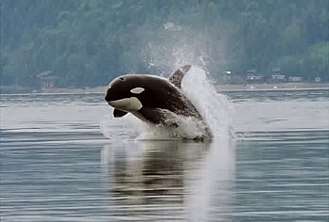
.jpg)
Killer whales are found in all oceans and most seas. Due to their enormous range, numbers, and density, relative distribution is difficult to estimate,[72] but they clearly prefer higher latitudes and coastal areas over pelagic environments.[73] Areas which serve as major study sites for the species include the coasts of Iceland, Norway, the Valdes Peninsula of Argentina, the Crozet Islands, New Zealand and parts of the west coast of North America, from California to Alaska.[74]
Systematic surveys indicate the highest densities of killer whales (>0.40 individuals per 100 km2) in the northeast Atlantic around the Norwegian coast, in the north Pacific along the Aleutian Islands, the Gulf of Alaska and in the Southern Ocean off much of the coast of Antarctica.[72] They are considered "common" (0.20–0.40 individuals per 100 km2) in the eastern Pacific along the coasts of British Columbia, Washington and Oregon, in the North Atlantic Ocean around Iceland and the Faroe Islands. High densities have also been reported but not quantified in the western North Pacific around the Sea of Japan, Sea of Okhotsk, Kuril Islands, Kamchatka and the Commander Islands and in the Southern Hemisphere off southern Brazil and the tip of southern Africa. They are reported as seasonally common in the Canadian Arctic, including Baffin Bay between Greenland and Nunavut, as well as Tasmania and Macquarie Island.[72] Regularly occurring or distinct populations exist off Northwest Europe, California, Patagonia, the Crozet Islands, Marion Island, southern Australia and New Zealand.[36][72][75] The northwest Atlantic population of at least 67 individuals ranges from Labrador and Newfoundland to New England with sightings to Cape Cod and Long Island.[76]
Information for offshore regions and warmer waters is more scarce, but widespread sightings indicate that the killer whale can survive in most water temperatures. They have been sighted, though more infrequently, in the Mediterranean, the Arabian Sea, the Gulf of Mexico, Banderas Bay on Mexico's west coast and the Caribbean.[72] Over 50 individual whales have been documented in the northern Indian Ocean, including two individuals that were sighted in the Persian Gulf in 2008 and off Sri Lanka in 2015.[77] Those orcas may occasionally enter the Red Sea through the Gulf of Aden.[78] The modern status of the species along coastal mainland China and its vicinity is unknown. Recorded sightings have been made from almost the entire shoreline.[79] A wide-ranging population is likely to exist in the central Pacific, with some sightings off Hawaii.[80][81] Distinct populations may also exist off the west coast of tropical Africa,[82] and Papua New Guinea.[83] In the Mediterranean, killer whales are considered "visitors", likely from the North Atlantic, and sightings become less frequent further east. However, a small year-round population is known to exist in the Strait of Gibraltar, mostly on the Atlantic side.[84][85] Killer whales also appear to regularly occur off the Galápagos Islands.[86]
In the Antarctic, killer whales range up to the edge of the pack ice and are believed to venture into the denser pack ice, finding open leads much like beluga whales in the Arctic. However, killer whales are merely seasonal visitors to Arctic waters, and do not approach the pack ice in the summer. With the rapid Arctic sea ice decline in the Hudson Strait, their range now extends deep into the northwest Atlantic.[87] Occasionally, killer whales swim into freshwater rivers. They have been documented 100 mi (160 km) up the Columbia River in the United States.[88][89] They have also been found in the Fraser River in Canada and the Horikawa River in Japan.[88]
Migration patterns are poorly understood. Each summer, the same individuals appear off the coasts of British Columbia and Washington. Despite decades of research, where these animals go for the rest of the year remains unknown. Transient pods have been sighted from southern Alaska to central California.[90]
Population
Worldwide population estimates are uncertain, but recent consensus suggests a minimum of 50,000 (2006).[91][3][30] Local estimates include roughly 25,000 in the Antarctic, 8,500 in the tropical Pacific, 2,250–2,700 off the cooler northeast Pacific and 500–1,500 off Norway.[92] Japan's Fisheries Agency estimated in the 2000s that 2,321 killer whales were in the seas around Japan.[93][94]
Feeding
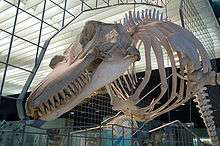
Killer whales are apex predators, meaning that they themselves have no natural predators. They are sometimes called the wolves of the sea, because they hunt in groups like wolf packs.[95] Killer whales hunt varied prey including fish, cephalopods, mammals, seabirds, and sea turtles.[96] Different populations or ecotypes may specialize, and some can have a dramatic impact on prey species.[97] However, whales in tropical areas appear to have more generalized diets due to lower food productivity.[81][82] Killer whales spend most of their time at shallow depths,[98] but occasionally dive several hundred meters depending on their prey.[99][100]
Fish
.jpg)
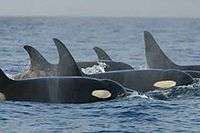
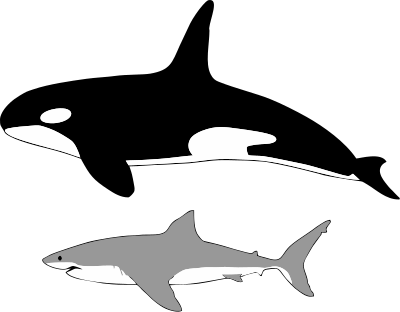
Fish-eating killer whales prey on around 30 species of fish. Some populations in the Norwegian and Greenland sea specialize in herring and follow that fish's autumnal migration to the Norwegian coast. Salmon account for 96% of northeast Pacific residents' diet, including 65% of large, fatty Chinook.[101] Chum salmon are also eaten, but smaller sockeye and pink salmon are not a significant food item.[102] Depletion of specific prey species in an area is, therefore, cause for concern for local populations, despite the high diversity of prey. On average, a killer whale eats 227 kilograms (500 lb) each day.[103] While salmon are usually hunted by an individual whale or a small group, herring are often caught using carousel feeding: the killer whales force the herring into a tight ball by releasing bursts of bubbles or flashing their white undersides. They then slap the ball with their tail flukes, stunning or killing up to 15 fish at a time, then eating them one by one. Carousel feeding has only been documented in the Norwegian killer whale population, as well as some oceanic dolphin species.[104]
In New Zealand, sharks and rays appear to be important prey, including eagle rays, long-tail and short-tail stingrays, common threshers, smooth hammerheads, blue sharks, basking sharks, and shortfin makos.[105][106] With sharks, orcas may herd them to the surface and strike them with their tail flukes,[105] while bottom-dwelling rays are cornered, pinned to the ground and taken to the surface.[107] In other parts of the world, killer whales have preyed on broadnose sevengill sharks,[108] tiger sharks[109] and even small whale sharks.[110] Killer whales have also been recorded attacking and feeding on great white sharks,[28][111][112][113] and appear to target the liver.[28][112] Competition between killer whales and white sharks is probable in regions where their diets overlap.[114] The arrival of orcas in an area can cause white sharks to flee and forage elsewhere.[115]
Mammals and birds
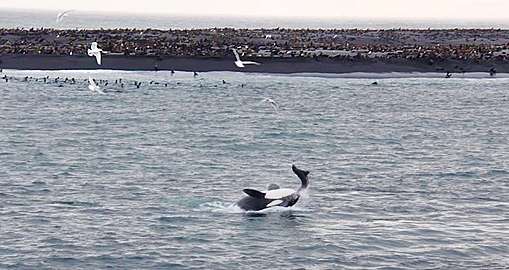
Killer whales are very sophisticated and effective predators of marine mammals. Thirty-two cetacean species have been recorded as prey, from observing orcas' feeding activity, examining the stomach contents of dead orcas, and seeing scars on the bodies of surviving prey animals. Groups even attack larger cetaceans such as minke whales, grey whales,[116] and, rarely, sperm whales or blue whales.[34][117][118][119] It has been hypothesized that predation by orcas on whale calves in high-productivity, high-latitude areas is the reason for great whale migrations during breeding season to low-productivity tropical waters where orcas are scarcer.[120]
Hunting a large whale usually takes several hours. Killer whales generally attack young or weak animals; however, a group of five or more may attack a healthy adult. When hunting a young whale, a group chases it and its mother to exhaustion. Eventually, they separate the pair and surround the calf, drowning it by keeping it from surfacing. Pods of female sperm whales sometimes protect themselves by forming a protective circle around their calves with their flukes facing outwards, using them to repel the attackers.[121] Rarely, large killer whale pods can overwhelm even adult female sperm whales. Adult bull sperm whales, which are large, powerful and aggressive when threatened, and fully grown adult blue whales, which are possibly too large to overwhelm, are not believed to be prey for killer whales.[122]
Prior to the advent of industrial whaling, great whales may have been the major food source for killer whales. The introduction of modern whaling techniques may have aided killer whales by the sound of exploding harpoons indicating availability of prey to scavenge, and compressed air inflation of whale carcasses causing them to float, thus exposing them to scavenging. However, the devastation of great whale populations by unfettered whaling has possibly reduced their availability for killer whales, and caused them to expand their consumption of smaller marine mammals, thus contributing to the decline of these as well.[120]
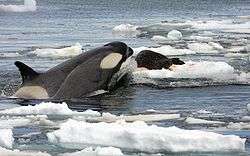
Other marine mammal prey species include nearly 20 species of seal, sea lion and fur seal. Walruses and sea otters are less frequently taken. Often, to avoid injury, killer whales disable their prey before killing and eating it. This may involve throwing it in the air, slapping it with their tails, ramming it, or breaching and landing on it.[123] In the Aleutian Islands, a decline in sea otter populations in the 1990s was controversially attributed by some scientists to killer whale predation, although with no direct evidence.[124] The decline of sea otters followed a decline in harbour seal and Steller sea lion populations, the killer whale's preferred prey,[lower-alpha 1][126] which in turn may be substitutes for their original prey, now decimated by industrial whaling.[127][128][129]
In steeply banked beaches off Península Valdés, Argentina, and the Crozet Islands, killer whales feed on South American sea lions and southern elephant seals in shallow water, even beaching temporarily to grab prey before wriggling back to the sea. Beaching, usually fatal to cetaceans, is not an instinctive behaviour, and can require years of practice for the young.[130] Killer whales can then release the animal near juvenile whales, allowing the younger whales to practice the difficult capture technique on the now-weakened prey.[123][131] "Wave-hunting" killer whales spy-hop to locate Weddell seals, crabeater seals, leopard seals, and penguins resting on ice floes, and then swim in groups to create waves that wash over the floe. This washes the prey into the water, where other killer whales lie in wait.[49][132][133]
Killer whales have also been observed preying on terrestrial mammals, such as deer swimming between islands off the northwest coast of North America.[125] Killer whale cannibalism has also been reported based on analysis of stomach contents, but this is likely to be the result of scavenging remains dumped by whalers.[134] One killer whale was also attacked by its companions after being shot.[34] Although resident killer whales have never been observed to eat other marine mammals, they occasionally harass and kill porpoises and seals for no apparent reason.[135]
Killer whales in many areas may prey on cormorants and gulls.[136] A captive killer whale at Marineland of Canada discovered it could regurgitate fish onto the surface, attracting sea gulls, and then eat the birds. Four others then learned to copy the behaviour.[137]
Behaviour
Day-to-day killer whale behaviour generally consists of foraging, travelling, resting and socializing. Killer whales frequently engage in surface behaviour such as breaching (jumping completely out of the water) and tail-slapping. These activities may have a variety of purposes, such as courtship, communication, dislodging parasites, or play. Spyhopping is a behaviour in which a whale holds its head above water to view its surroundings.[138] Resident killer whales swim alongside porpoises and other dolphins.[139]
Social structure
.jpg)
Killer whales are notable for their complex societies. Only elephants and higher primates live in comparably complex social structures.[140] Due to orcas' complex social bonds, many marine experts have concerns about how humane it is to keep them in captivity.[141]
Resident killer whales in the eastern North Pacific live in particularly complex and stable social groups. Unlike any other known mammal social structure, resident whales live with their mothers for their entire lives. These family groups are based on matrilines consisting of the eldest female (matriarch) and her sons and daughters, and the descendants of her daughters, etc. The average size of a matriline is 5.5 animals.[142] Because females can reach age 90, as many as four generations travel together. These matrilineal groups are highly stable. Individuals separate for only a few hours at a time, to mate or forage. With one exception, a killer whale named Luna, no permanent separation of an individual from a resident matriline has been recorded.[142]
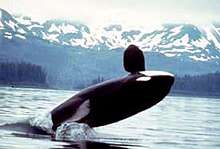
Closely related matrilines form loose aggregations called pods, usually consisting of one to four matrilines. Unlike matrilines, pods may separate for weeks or months at a time.[142] DNA testing indicates resident males nearly always mate with females from other pods.[143] Clans, the next level of resident social structure, are composed of pods with similar dialects, and common but older maternal heritage. Clan ranges overlap, mingling pods from different clans.[142] The final association layer, perhaps more arbitrarily defined than the familial groupings, is called the community, and is defined as a set of clans that regularly commingle. Clans within a community do not share vocal patterns.[lower-alpha 2]
Transient pods are smaller than resident pods, typically consisting of an adult female and one or two of her offspring. Males typically maintain stronger relationships with their mothers than other females. These bonds can extend well into adulthood. Unlike residents, extended or permanent separation of transient offspring from natal matrilines is common, with juveniles and adults of both sexes participating. Some males become "rovers" and do not form long-term associations, occasionally joining groups that contain reproductive females.[144] As in resident clans, transient community members share an acoustic repertoire, although regional differences in vocalizations have been noted.[145]
Vocalizations
| Multimedia relating to the orca |
Like all cetaceans, killer whales depend heavily on underwater sound for orientation, feeding, and communication. They produce three categories of sounds: clicks, whistles, and pulsed calls. Clicks are believed to be used primarily for navigation and discriminating prey and other objects in the surrounding environment, but are also commonly heard during social interactions.[30]
Northeast Pacific resident groups tend to be much more vocal than transient groups in the same waters.[146] Residents feed primarily on Chinook and chum, which are insensitive to killer whale calls (inferred from the audiogram of Atlantic salmon). In contrast, the marine mammal prey of transients hear whale calls well. Transients are typically silent.[146] They sometimes use a single click (called a cryptic click) rather than the long train of clicks observed in other populations. Residents are silent only when resting.
All members of a resident pod use similar calls, known collectively as a dialect. Dialects are composed of specific numbers and types of discrete, repetitive calls. They are complex and stable over time.[147] Call patterns and structure are distinctive within matrilines.[148] Newborns produce calls similar to their mothers, but have a more limited repertoire.[145] Individuals likely learn their dialect through contact with pod members.[149] Family-specific calls have been observed more frequently in the days following a calf's birth, which may help the calf learn them.[150] Dialects are probably an important means of maintaining group identity and cohesiveness. Similarity in dialects likely reflects the degree of relatedness between pods, with variation growing over time.[151] When pods meet, dominant call types decrease and subset call types increase. The use of both call types is called biphonation. The increased subset call types may be the distinguishing factor between pods and inter-pod relations.[148]
Dialects also distinguish types. Resident dialects contain seven to 17 (mean = 11) distinctive call types. All members of the North American west coast transient community express the same basic dialect, although minor regional variation in call types is evident. Preliminary research indicates offshore killer whales have group-specific dialects unlike those of residents and transients.[151]
Norwegian and Icelandic herring-eating orcas appear to have different vocalizations for activities like hunting.[152] A population that live in McMurdo Sound, Antarctica have 28 complex burst-pulse and whistle calls.[153]
Intelligence
Killer whales have the second-heaviest brains among marine mammals[154] (after sperm whales, which have the largest brain of any animal). They can be trained in captivity and are often described as intelligent,[155][156] although defining and measuring "intelligence" is difficult in a species whose environment and behavioural strategies are very different from those of humans.[156]
Killer whales imitate others, and seem to deliberately teach skills to their kin. Off the Crozet Islands, mothers push their calves onto the beach, waiting to pull the youngster back if needed.[123][131]
People who have interacted closely with killer whales offer numerous anecdotes demonstrating the whales' curiosity, playfulness, and ability to solve problems. Alaskan killer whales have not only learned how to steal fish from longlines, but have also overcome a variety of techniques designed to stop them, such as the use of unbaited lines as decoys.[157] Once, fishermen placed their boats several miles apart, taking turns retrieving small amounts of their catch, in the hope that the whales would not have enough time to move between boats to steal the catch as it was being retrieved. A researcher described what happened next:
It worked really well for a while. Then the whales split into two groups. It didn't even take them an hour to figure it out. They were so thrilled when they figured out what was going on, that we were playing games. They were breaching by the boats.
— Craig Matkin[157]
In other anecdotes, researchers describe incidents in which wild killer whales playfully tease humans by repeatedly moving objects the humans are trying to reach,[158] or suddenly start to toss around a chunk of ice after a human throws a snowball.[159]
The killer whale's use of dialects and the passing of other learned behaviours from generation to generation have been described as a form of animal culture.[160]
The complex and stable vocal and behavioural cultures of sympatric groups of killer whales (Orcinus orca) appear to have no parallel outside humans and represent an independent evolution of cultural faculties.[161]
(Two species or populations are considered sympatric when they live in the same geographic area and thus regularly encounter one another.)
Life cycle
.jpg)
Female killer whales begin to mature at around the age of 10 and reach peak fertility around 20,[162] experiencing periods of polyestrous cycling separated by non-cycling periods of three to 16 months. Females can often breed until age 40, followed by a rapid decrease in fertility.[162] As such, orcas are among the few animals that undergo menopause and live for decades after they have finished breeding.[163][164] The lifespans of wild females average 50 to 80 years.[165] Some are claimed to have lived substantially longer: Granny (J2) was estimated by some researchers to have been as old as 105 years at the time of her death, though a biopsy sample indicated her age as 65 to 80 years.[166][167][168] Orcas held in captivity tend to live less than those in the wild, although this is subject to scientific debate.[165][169][170]
To avoid inbreeding, males mate with females from other pods. Gestation varies from 15 to 18 months. [171] Mothers usually calve a single offspring about once every five years. In resident pods, births occur at any time of year, although winter is the most common. Mortality is extremely high during the first seven months of life, when 37–50% of all calves die.[172] Weaning begins at about 12 months of age, and is complete by two years. According to observations in several regions, all male and female pod members participate in the care of the young.[140]
Males sexually mature at the age of 15, but do not typically reproduce until age 21. Wild males live around 29 years on average, with a maximum of about 60 years.[166] One male, known as Old Tom, was reportedly spotted every winter between the 1840s and 1930 off New South Wales, Australia. This would have made him up to 90 years old. Examination of his teeth indicated he died around age 35,[173] but this method of age determination is now believed to be inaccurate for older animals.[174] One male known to researchers in the Pacific Northwest (identified as J1) was estimated to have been 59 years old when he died in 2010.[175] Killer whales are unique among cetaceans, as their caudal sections elongate with age, making their heads relatively shorter.[60]
Infanticide, once thought to occur only in captive killer whales, was observed in wild populations by researchers off British Columbia on December 2, 2016. In this incident, an adult male killed the calf of a female within the same pod, with his mother also joining in the assault. It is theorized that the male killed the young calf in order to mate with its mother (something that occurs in other carnivore species), while the male's mother supported the breeding opportunity for her son. The attack ended when the calf's mother struck and injured the attacking male. Such behaviour matches that of many smaller dolphin species, such as the bottlenose dolphin.[176]
Conservation
In 2008, the IUCN (International Union for Conservation of Nature) changed its assessment of the killer whale's conservation status from conservation dependent to data deficient, recognizing that one or more killer whale types may actually be separate, endangered species.[3] Depletion of prey species, pollution, large-scale oil spills, and habitat disturbance caused by noise and conflicts with boats are the most significant worldwide threats.[3] In January 2020, the first killer whale in England and Wales since 2001 was found dead with a large fragment of plastic in its stomach.[177]
Like other animals at the highest trophic levels, the killer whale is particularly at risk of poisoning from bioaccumulation of toxins, including Polychlorinated biphenyls (PCBs).[178] European harbour seals have problems in reproductive and immune functions associated with high levels of PCBs and related contaminants, and a survey off the Washington coast found PCB levels in killer whales were higher than levels that had caused health problems in harbour seals.[178] Blubber samples in the Norwegian Arctic show higher levels of PCBs, pesticides and brominated flame-retardants than in polar bears. When food is scarce, killer whales metabolize blubber for energy, which increases pollutant concentrations in their blood.
In the Pacific Northwest, wild salmon stocks, a main resident food source, have declined dramatically in recent years.[3] In the Puget Sound region only 75 whales remain with few births over the last few years.[179] On the west coast of Alaska and the Aleutian Islands, seal and sea lion populations have also substantially declined.[180]
In 2005, the United States government listed the southern resident community as an endangered population under the Endangered Species Act.[30] This community comprises three pods which live mostly in the Georgia and Haro Straits and Puget Sound in British Columbia and Washington. They do not breed outside of their community, which was once estimated at around 200 animals and later shrank to around 90.[181] In October 2008, the annual survey revealed seven were missing and presumed dead, reducing the count to 83.[182] This is potentially the largest decline in the population in the past 10 years. These deaths can be attributed to declines in Chinook salmon.[182]
Scientist Ken Balcomb has extensively studied killer whales since 1976; he is the research biologist responsible for discovering U.S. Navy sonar may harm killer whales. He studied killer whales from the Center for Whale Research, located in Friday Harbor, Washington.[183] He was also able to study killer whales from "his home porch perched above Puget Sound, where the animals hunt and play in summer months".[183] In May 2003, Balcomb (along with other whale watchers near the Puget Sound coastline) noticed uncharacteristic behaviour displayed by the killer whales. The whales seemed "agitated and were moving haphazardly, attempting to lift their heads free of the water" to escape the sound of the sonars.[183] "Balcomb confirmed at the time that strange underwater pinging noises detected with underwater microphones were sonar. The sound originated from a U.S. Navy frigate 12 miles (19 kilometres) distant, Balcomb said."[183] The impact of sonar waves on killer whales is potentially life-threatening. Three years prior to Balcomb's discovery, research in the Bahamas showed 14 beaked whales washed up on the shore. These whales were beached on the day U.S. Navy destroyers were activated into sonar exercise.[183] Of the 14 whales beached, six of them died. These six dead whales were studied, and CAT scans of two of the whale heads showed hemorrhaging around the brain and the ears, which is consistent with decompression sickness.[183]
Another conservation concern was made public in September 2008 when the Canadian government decided it was not necessary to enforce further protections (including the Species at Risk Act in place to protect endangered animals along their habitats) for killer whales aside from the laws already in place. In response to this decision, six environmental groups sued the federal government, claiming killer whales were facing many threats on the British Columbia Coast and the federal government did nothing to protect them from these threats.[184] A legal and scientific nonprofit organization, Ecojustice, led the lawsuit and represented the David Suzuki Foundation, Environmental Defence, Greenpeace Canada, International Fund for Animal Welfare, the Raincoast Conservation Foundation, and the Wilderness Committee.[184] Many scientists involved in this lawsuit, including Bill Wareham, a marine scientist with the David Suzuki Foundation, noted increased boat traffic, water toxic wastes, and low salmon population as major threats, putting approximately 87 killer whales[184] on the British Columbia Coast in danger.
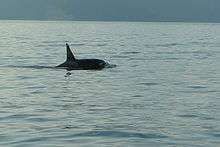
Underwater noise from shipping, drilling, and other human activities is a significant concern in some key killer whale habitats, including Johnstone Strait and Haro Strait.[185] In the mid-1990s, loud underwater noises from salmon farms were used to deter seals. Killer whales also avoided the surrounding waters.[186] High-intensity sonar used by the Navy disturbs killer whales along with other marine mammals.[187] Killer whales are popular with whale watchers, which may stress the whales and alter their behaviour, particularly if boats approach too closely or block their lines of travel.[188]
The Exxon Valdez oil spill adversely affected killer whales in Prince William Sound and Alaska's Kenai Fjords region. Eleven members (about half) of one resident pod disappeared in the following year. The spill damaged salmon and other prey populations, which in turn damaged local killer whales. By 2009, scientists estimated the AT1 transient population (considered part of a larger population of 346 transients), numbered only seven individuals and had not reproduced since the spill. This population is expected to die out.[189][190]
A 2018 study published in Science found that global killer whale populations are poised to dramatically decline due to exposure to toxic chemical and PCB pollution.[191]
Relationship with humans
Indigenous cultures
The indigenous peoples of the Pacific Northwest Coast feature killer whales throughout their art, history, spirituality and religion. The Haida regarded killer whales as the most powerful animals in the ocean, and their mythology tells of killer whales living in houses and towns under the sea. According to these myths, they took on human form when submerged, and humans who drowned went to live with them.[192] For the Kwakwaka'wakw, the killer whale was regarded as the ruler of the undersea world, with sea lions for slaves and dolphins for warriors.[192] In Nuu-chah-nulth and Kwakwaka'wakw mythology, killer whales may embody the souls of deceased chiefs.[192] The Tlingit of southeastern Alaska regarded the killer whale as custodian of the sea and a benefactor of humans.[193]
The Maritime Archaic people of Newfoundland also had great respect for killer whales, as evidenced by stone carvings found in a 4,000-year-old burial at the Port au Choix Archaeological Site.[194][195]
In the tales and beliefs of the Siberian Yupik people, killer whales are said to appear as wolves in winter, and wolves as killer whales in summer.[196][197][198][199] Killer whales are believed to assist their hunters in driving walrus.[200] Reverence is expressed in several forms: the boat represents the animal, and a wooden carving hung from the hunter's belt.[198] Small sacrifices such as tobacco or meat are strewn into the sea for them.[200][199]
Indigenous Ainu tribe often referred killer whales in their folklore and myth as Repun Kamuy (God of Sea/Offshore) to bring fortunes (whales) to the coasts, and there had been traditional funerals for stranded or deceased orcas akin to funerals for other animals such as brown bears.[201]
"Killer" stereotype
In Western cultures, killer whales were historically feared as dangerous, savage predators.[202] The first written description of a killer whale was given by Pliny the Elder circa AD 70, who wrote, "Orcas (the appearance of which no image can express, other than an enormous mass of savage flesh with teeth) are the enemy of [other kinds of whale]... they charge and pierce them like warships ramming."[203]
Of the very few confirmed attacks on humans by wild killer whales, none have been fatal.[204] In one instance, killer whales tried to tip ice floes on which a dog team and photographer of the Terra Nova Expedition were standing.[205] The sled dogs' barking is speculated to have sounded enough like seal calls to trigger the killer whale's hunting curiosity. In the 1970s, a surfer in California was bitten, and in 2005, a boy in Alaska who was splashing in a region frequented by harbour seals was bumped by a killer whale that apparently misidentified him as prey.[206] Unlike wild killer whales, captive killer whales have made nearly two dozen attacks on humans since the 1970s, some of which have been fatal.[207][208]
Competition with fishermen also led to killer whales being regarded as pests. In the waters of the Pacific Northwest and Iceland, the shooting of killer whales was accepted and even encouraged by governments.[202] As an indication of the intensity of shooting that occurred until fairly recently, about 25% of the killer whales captured in Puget Sound for aquarium through 1970 bore bullet scars.[209] The U.S. Navy claimed to have deliberately killed hundreds of killer whales in Icelandic waters in 1956 with machine guns, rockets, and depth charges.[210][211]
Modern Western attitudes
Western attitudes towards killer whales have changed dramatically in recent decades. In the mid-1960s and early 1970s, killer whales came to much greater public and scientific awareness, starting with the first live-capture and display of a killer whale known as Moby Doll, a resident harpooned off Saturna Island in 1964.[202] So little was known at the time, it was nearly two months before the whale's keepers discovered what food (fish) it was willing to eat. To the surprise of those who saw him, Moby Doll was a docile, non-aggressive whale who made no attempts to attack humans.[212]
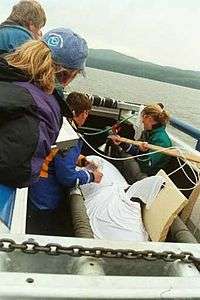
Between 1964 and 1976, 50 killer whales from the Pacific Northwest were captured for display in aquaria, and public interest in the animals grew. In the 1970s, research pioneered by Michael Bigg led to the discovery of the species' complex social structure, its use of vocal communication, and its extraordinarily stable mother–offspring bonds. Through photo-identification techniques, individuals were named and tracked over decades.[213]
Bigg's techniques also revealed the Pacific Northwest population was in the low hundreds rather than the thousands that had been previously assumed.[202] The southern resident community alone had lost 48 of its members to captivity; by 1976, only 80 remained.[214] In the Pacific Northwest, the species that had unthinkingly been targeted became a cultural icon within a few decades.[181]
The public's growing appreciation also led to growing opposition to whale–keeping in aquarium. Only one whale has been taken in North American waters since 1976. In recent years, the extent of the public's interest in killer whales has manifested itself in several high-profile efforts surrounding individuals. Following the success of the 1993 film Free Willy, the movie's captive star Keiko was returned to the coast of his native Iceland in 2002. The director of the International Marine Mammal Project for the Earth Island Institute, David Phillips, led the efforts to return Keiko to the Iceland waters.[215] Keiko however did not adapt to the harsh climate of the Arctic Ocean, and died a year into his release after contracting pneumonia, at the age of 27.[216] In 2002, the orphan Springer was discovered in Puget Sound, Washington. She became the first whale to be successfully reintegrated into a wild pod after human intervention, crystallizing decades of research into the vocal behaviour and social structure of the region's killer whales.[217] The saving of Springer raised hopes that another young killer whale named Luna, which had become separated from his pod, could be returned to it. However, his case was marked by controversy about whether and how to intervene, and in 2006, Luna was killed by a boat propeller.[218]
Whaling
The earlier of known records of commercial hunting of killer whales date to the 18th century in Japan. During the 19th and early 20th centuries, the global whaling industry caught immense numbers of baleen and sperm whales, but largely ignored killer whales because of their limited amounts of recoverable oil, their smaller populations, and the difficulty of taking them.[143] Once the stocks of larger species were depleted, killer whales were targeted by commercial whalers in the mid-20th century. Between 1954 and 1997, Japan took 1,178 killer whales (although the Ministry of the Environment claims that there had been domestic catches of about 1,600 whales between late 1940s to 1960s[219]) and Norway took 987.[220] Extensive hunting of killer whales, including an Antarctic catch of 916 in 1979–80 alone, prompted the International Whaling Commission to recommend a ban on commercial hunting of the species pending further research.[220] Today, no country carries out a substantial hunt, although Indonesia and Greenland permit small subsistence hunts (see Aboriginal whaling). Other than commercial hunts, killer whales were hunted along Japanese coasts out of public concern for potential conflicts with fisheries. Such cases include a semi-resident male-female pair in Akashi Strait and Harimanada being killed in the Seto Inland Sea in 1957,[221][222] the killing of five whales from a pod of 11 members that swam into Tokyo Bay in 1970,[223] and a catch record in southern Taiwan in the 1990s.[79][224]
Cooperation with humans
Killer whales have helped humans hunting other whales.[225] One well-known example was the killer whales of Eden, Australia, including the male known as Old Tom. Whalers more often considered them a nuisance, however, as orcas would gather to scavenge meat from the whalers' catch.[225] Some populations, such as in Alaska's Prince William Sound, may have been reduced significantly by whalers shooting them in retaliation.[16]
Whale watching
Whale watching continues to increase in popularity, but may have some problematic impacts on killer whales. Exposure to exhaust gasses from large amounts of vessel traffic are causing concern for the overall health of the 75 remaining southern resident killer whales (SRKWs) left as of early 2019.[226] This population is followed by approximately 20 vessels for 12 hours a day during the months May–September.[227] Researchers discovered that these vessels are in the line of sight for these whales for 98–99.5% of daylight hours.[227] With so many vessels, the air quality around these whales deteriorates and impacts their health. Air pollutants that bind with exhaust fumes are responsible for the activation of the cytochrome P450 1A gene family.[227] Researchers have successfully identified this gene in skin biopsies of live whales and also the lungs of deceased whales. A direct correlation between activation of this gene and the air pollutants can not be made because there are other known factors that will induce the same gene. Vessels can have either wet or dry exhaust systems, with wet exhaust systems leaving more pollutants in the water due to various gas solubility. A modelling study determined that the lowest-observed-adverse-effect-level (LOAEL) of exhaust pollutants was about 12% of the human dose.[227]
As a response to this, in 2017 boats off the British Columbia coast now have a minimum approach distance of 200 metres compared to the previous 100 metres. This new rule complements Washington State's minimum approach zone of 180 metres that has been in effect since 2011. If a whale approaches a vessel it must be placed in neutral until the whale passes. The World Health Organization has set air quality standards in an effort to control the emissions produced by these vessels.[228]
Captivity
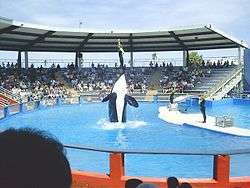
The killer whale's intelligence, trainability, striking appearance, playfulness in captivity and sheer size have made it a popular exhibit at aquaria and aquatic theme parks. From 1976 to 1997, 55 whales were taken from the wild in Iceland, 19 from Japan, and three from Argentina. These figures exclude animals that died during capture. Live captures fell dramatically in the 1990s, and by 1999, about 40% of the 48 animals on display in the world were captive-born.[229]
Organizations such as World Animal Protection and the Whale and Dolphin Conservation campaign against the practice of keeping them in captivity. In captivity, they often develop pathologies, such as the dorsal fin collapse seen in 60–90% of captive males. Captives have vastly reduced life expectancies, on average only living into their 20s.[lower-alpha 3] In the wild, females who survive infancy live 46 years on average, and up to 70–80 years in rare cases. Wild males who survive infancy live 31 years on average, and up to 50–60 years.[230] Captivity usually bears little resemblance to wild habitat, and captive whales' social groups are foreign to those found in the wild. Critics claim captive life is stressful due to these factors and the requirement to perform circus tricks that are not part of wild killer whale behaviour, see above.[231] Wild killer whales may travel up to 160 kilometres (100 mi) in a day, and critics say the animals are too big and intelligent to be suitable for captivity.[155] Captives occasionally act aggressively towards themselves, their tankmates, or humans, which critics say is a result of stress.[207] Between 1991 and 2010, the bull orca known as Tilikum was involved in the death of three people, and was featured in the critically acclaimed 2013 film Blackfish.[232] Tilikum lived at SeaWorld from 1992 until his death in 2017.[233][234][235][236][237]
A 2015 study coauthored by staff at SeaWorld and the Minnesota Zoo indicates that there is no significant difference in survivorship between free-ranging and captive killer whales. The authors speculate about the future utility of studying captive populations for the purposes of understanding orca biology and the implications of such research of captive animals in the overall health of both wild and marine park populations.[238]
As of March 2016, SeaWorld has announced that they will be ending their orca breeding program and their theatrical shows. They previously announced, in November 2015, that the shows would be coming to an end in San Diego but it is now to happen in both Orlando and San Antonio as well.[239]
See also
- List of marine mammal species
- List of cetaceans
- Livyatan melvillei – occupied a similar ecological niche
- List of cetaceans
- List of whale vocalizations
- Ingrid Visser (researcher) – a New Zealand biologist who swims with wild killer whales
- Marine biology
- Sinonyx
Footnotes
- According to Baird,[125] killer whales prefer harbour seals to sea lions and porpoises in some areas.
- In the northeast Pacific, three communities of fish-eating killer whales have been identified: the southern community (one clan, three pods, 90 killer whales as of 2006), the northern community (three clans, 16 pods, 214 killer whales as of 2000), and the south Alaskan community (two clans, 11 pods, 211 killer whales as of 2000).
- Although there are examples of killer whales living longer, including several over 30 years old, and two captive orcas (Corky II and Lolita) are in their mid-40s.
References
- Mead, J.G.; Brownell, R. L. Jr. (2005). "Order Cetacea". In Wilson, D.E.; Reeder, D.M (eds.). Mammal Species of the World: A Taxonomic and Geographic Reference (3rd ed.). Johns Hopkins University Press. pp. 723–743. ISBN 978-0-8018-8221-0. OCLC 62265494.
- "Orcinus orca Linnaeus 1758". Fossilworks. Retrieved April 28, 2018.
- Reeves, R.; Pitman, R.L.; Ford, J.K.B. (2017). "Orcinus orca". IUCN Red List of Threatened Species. 2017: e.T15421A50368125. Retrieved February 15, 2020.CS1 maint: ref=harv (link)
- "Orcinus Fitzinger, 1860". Integrated Taxonomic Information System. Retrieved March 9, 2011.
- "Orcinus orca (Linnaeus, 1758)". Integrated Taxonomic Information System. Retrieved March 9, 2011.
- Linnaeus, C. (1758). Systema naturae per regna tria naturae, secundum classes, ordines, genera, species, cum characteribus, differentiis, synonymis, locis. Tomus I (in Latin). v.1 (10th ed.). Holmiae. (Laurentii Salvii). p. 824.
- Zum Wal in der Marienkirche (in German). St. Mary's Church, Greifswald. Retrieved February 16, 2010
- Carwardine 2001, p. 19.
- LeDuc, R. G.; Perrin, W. F.; Dizon, A.E. (1999). "Phylogenetic relationships among the delphinid cetaceans based on full cytochrome b sequences". Marine Mammal Science. 15 (3): 619–648. doi:10.1111/j.1748-7692.1999.tb00833.x.
- Horreo, Jose L. (2018). "New insights into the phylogenetic relationships among the oceanic dolphins (Cetacea: Delphinidae)". Journal of Zoological Systematics and Evolutionary Research. 57 (2): 476–480. doi:10.1111/jzs.12255.
- Mary Price (July 22, 2013). "Orcas: How Science Debunked Superstition". National Wildlife Federation. Retrieved July 30, 2020.
- Ford, Ellis & Balcomb 2000, p. 69.
- Killer Whales. Scientific Classification Archived August 15, 2012, at the Wayback Machine, Seaworld.org, September 23, 2010, Retrieved September 9, 2010.
- Best, P.B. 2007 Whales and Dolphins of the Southern African Subregion ISBN 978-0-521-89710-5
- Leatherwood, Stephen and Larry J. Hobbs (1988). Whales, dolphins, and porpoises of the eastern North Pacific and adjacent Arctic waters: a guide to their identification, p. 118. Courier Dover Publications. ISBN 0-486-25651-0 Retrieved January 28, 2010.
- (Baird 2002). Status of Killer Whales in Canada. Contract report to the Committee on the Status of Endangered Wildlife in Canada, Ottawa, ON, Canada. Also published as Status of Killer Whales, Orcinus orca, in Canada The Canadian Field-Naturalist 115 (4) (2001), 676–701. Retrieved January 26, 2010.
- Pitman, Robert L.; Ensor, Paul (2003). "Three forms of killer whales (Orcinus orca) in Antarctic waters" (PDF). Journal of Cetacean Research and Management. 5 (2): 131–139.
- De Bruyn, P. J. N.; Tosh, C. A.; Terauds, A. (2013). "Killer whale ecotypes: Is there a global model?". Biological Reviews. 88 (1): 62–80. doi:10.1111/j.1469-185X.2012.00239.x. hdl:2263/21531. PMID 22882545.
- Ford, J.K.B.; Ellis, G.M.; Barrett-Lennard, L.G.; Morton, A.B.; Palm, R.S.; Balcomb, K.C. (1998). "Dietary specialization in two sympatric populations of killer whales (Orcinus orca) in coastal British Columbia and adjacent waters". Canadian Journal of Zoology. 76 (8): 1456–1471. doi:10.1139/z98-089.
- Berta, Annalisa; Sumich, James L.; Kovacs, Kit M. (2006). Marine mammals: evolutionary biology. Academic Press. p. 387. ISBN 978-0-12-088552-7.
- Carwardine 2001, pp. 40–47.
- Ford, Ellis & Balcomb 2000, p. 23.
- Ford J.K.B. and, G.M. Ellis. 1999. Transients: Mammal-hunting killer whales of British Columbia, Washington, and Southeastern Alaska. UBC Press, Vancouver.
- Deecke, V.B.; Ford, J.K.B.; Slater, P.J.B. (2005). "The vocal behaviour of mammal-eating killer whales: Communicating with costly calls". Animal Behaviour. 69 (2): 395–405. doi:10.1016/j.anbehav.2004.04.014.
- NMFS 2005, p. 24.
- Bellaart, Darrell (December 4, 2012). "Transient label is pushed aside to honour renowned whale researcher". Nanaimo Daily News. Archived from the original on March 1, 2014. Retrieved December 4, 2012.
- Ford, Ellis & Balcomb 2000, p. 21.
- Pyle, Peter; Schramm, Mary Jane; Keiper, Carol; Anderson, Scot D. (1999). "Predation on a white shark (Carcharodon carcharias) by a killer whale (Orcinus orca) and a possible case of competitive displacement" (PDF). Marine Mammal Science. 15 (2): 563–568. doi:10.1111/j.1748-7692.1999.tb00822.x.
- Dahlheim, M.E.; Schulman-Janiger, A.; Black, N.; Ternullo, R.; Balcomb, K.C. (2008). "Eastern temperate North Pacific offshore killer whales (Orcinus orca): Occurrence, movements, and insights into feeding ecology". Marine Mammal Science. 24 (3): 719–729. doi:10.1111/j.1748-7692.2008.00206.x.
- "Killer whale (Orcinus orca)". NOAA Fisheries. Office of Protected Resources, National Marine Fisheries Service. Archived from the original on July 9, 2017. Retrieved August 15, 2017.
- Baird, R.W.; Dill, L.M. (1995). "Occurrence and behaviour of transient killer whales: seasonal and pod-specific variability, foraging behaviour, and prey handling". Canadian Journal of Zoology. 73 (7): 1300–1311. doi:10.1139/z95-154.
- Barrett-Lennard LG, Ellis GM. 2001. Population structure and genetic variability in northeastern Pacific killer whales: Towards an assessment of population viability. Canadian Science Advisory Secretariat, Ottawa, Canada.
- NMFS 2005, p. 23.
- Jefferson, T. A.; Stacey, P. J.; Baird, R. W. (1991). "A review of killer whale interactions with other marine mammals: predation to co-existence" (PDF). Mammal Review. 21 (4): 151–180. doi:10.1111/j.1365-2907.1991.tb00291.x.
- Bourton, Jody. Two killer whale types found in UK waters, Earth News, BBC, January 5, 2010. Retrieved February 23, 2010.
- Foote, Andrew D.; Newton, Jason; Piertney, Stuart B.; Willerslev, Eske; Gilbert, M. Thomas P. (2009). "Ecological, morphological and genetic divergence of sympatric North Atlantic killer whale populations" (PDF). Molecular Ecology. 18 (24): 5207–17. doi:10.1111/j.1365-294X.2009.04407.x. PMID 20050301.
- Waite, J.M.; Friday, N.A.; Moore, S.E. (2002). "Killer Whale (Orcinus orca) distribution and abundance in the central and southeastern Bering Sea, July 1999 and June 2000". Marine Mammal Science. 18 (3): 779–786. doi:10.1111/j.1748-7692.2002.tb01073.x.
- Christensen, I. 1984. Growth and reproduction of killer whales, Orcinus orca, in Norwegian coastal waters. Reports of the International Whaling Commission Special Issue, 6: 253–258.
- Ford, Ellis & Balcomb 2000, p. 27.
- Evans, W. E.; Yablokov, A. V.; Bowles, A. E. (1982). "Geographic Variation in the Color Pattern of Killer Whales (Orcinus orca)" (PDF). Reports of the International Whaling Commission. 32: 687–694. Archived from the original (PDF) on July 13, 2011.
- Gough, Myles (January 9, 2015). "First video footage of rare 'Type D' orcas". Science Alert.
- Tennenhouse, Erica (March 1, 2018). "Mysterious orcas filmed underwater for first time". National Geographic. Retrieved April 12, 2019.
- "Sea Shepherd documents rare 'Type D' orcas". GrindTV. January 5, 2015. Archived from the original on January 11, 2015. Retrieved January 6, 2015.
- Pitman, Robert L.; Durban, John W.; Greenfelder, Michael; Guinet, Christophe; Jorgensen, Morton; Olson, Paula A.; Plana, Jordi; Tixier, Paul; Towers, Jared R. (August 7, 2010). "Observations of a distinctive morphotype of killer whale (Orcinus orca), type D, from subantarctic waters". Polar Biology. 34 (2): 303–306. doi:10.1007/s00300-010-0871-3.
- Rejcek, Peter. "The Antarctic Sun: News about Antarctica – Killer News". Antarcticsun.usap.gov. Retrieved February 16, 2011.
- Gorter, Uko. Newsletter of the Puget Sound Chapter of the American Cetacean Society, Spring 2004. Retrieved February 16, 2010.
- Pitman, Robert L.; Robertson, Kelly M.; Leduc, Richard G. (2008). "Mitochondrial sequence divergence among Antarctic killer whale ecotypes is consistent with multiple species". Biology Letters. 4 (4): 426–9. doi:10.1098/rsbl.2008.0168. PMC 2610147. PMID 18524738.
- Morin, Phillip A; Archer, Frederick; Foote, Andrew D; Vilstrup, Julia; Allen, Eric E; Wade, Paul; Durban, John; Parsons, Kim; Pitman, Robert (2010). "Complete mitochondrial genome phylogeographic analysis of killer whales (Orcinus orca) indicates multiple species". Genome Research. 20 (7): 908–916. doi:10.1101/gr.102954.109. PMC 2892092. PMID 20413674.
- WADE, NICHOLAS (April 26, 2010). "Cracking Orca's Code: It Comes in Several Types". New York Times.
- Schrope, Mark (2007). "Food chains: Killer in the kelp". Nature. 445 (7129): 703–705. Bibcode:2007Natur.445..703S. doi:10.1038/445703a. PMID 17301765.
- Poncelet, Eric. Killer whale biology: Morphology. Retrieved February 16, 2010
- "Killer Whales: Physical Characteristics". Seaworld.org. Archived from the original on February 13, 2010. Retrieved December 30, 2009.
- Carwardine 2001, p. 20.
- "Wild Whales". Vancouver Aquarium. Archived from the original on April 5, 2012. Retrieved March 23, 2012.
- Heptner et al. 1996, p. 683.
- Baird 2002.
- Olsen, K. (2006). National Wildlife 44 (6) (October/November), 22–30
- Stewart, D. (2001). National Wildlife 39 (1) (December/January), 54–59
- Heyning, J. E.; Dahlheim, M. E. (1988). "Orcinus orca" (PDF). Mammalian Species. 304 (304): 1–9. doi:10.2307/3504225. JSTOR 3504225. Archived from the original (PDF) on January 18, 2012.
- Heptner et al. 1996, p. 681.
- Orca (Killer whale). American Cetacean Society. Retrieved January 2, 2009
- Ford, Ellis & Balcomb 2000, p. 45.
- Obee & Ellis 1992, pp. 1–27.
- Rare White Killer Whale Spotted in Alaskan Waters From NOAA Ship Oscar Dyson, news release, National Oceanic and Atmospheric Administration, March 6, 2008. Retrieved March 20, 2010
- Mary Pemberton. Rare white killer whale spotted in Alaska, NBC News, March 7, 2008
- "Russian scientists seeking white whale -- really". Fox News. April 23, 2012. Retrieved April 23, 2012.
- "White killer whale adult spotted for first time in wild". BBC News. April 23, 2012. Retrieved April 23, 2012.
- Carwardine 2001, pp. 30–32.
- "Killer Whales — Adaptations for an Aquatic Environment". Seaworld.org. Archived from the original on September 4, 2013. Retrieved September 14, 2013.
- N. W. Kasting, S. A. L. Adderly, T. Safford, K. G. Hewlett (1989). "Thermoregulation in Beluga (Delphinapterus luecas) and Killer (Orcinus orca) Whales"
- M. P. Spencer, T. A. Gornall, 3rd, and T. C. Poulter (1967). Respiratory and cardiac activity of killer whales.
- Forney, K.A.; Wade, P. (2007). "Worldwide distribution and abundance of killer whales" (PDF). In Estes, James A.; DeMaster, Douglas P.; Doak, Daniel F.; Williams, Terrie M.; Brownell, Robert L. Jr. (eds.). Whales, whaling and ocean ecosystems. Berkeley: University of California Press. pp. 145–162. ISBN 978-0-520-24884-7.
- Carwardine 2001, p. 21.
- Baird 2002, p. 128.
- Ling, J. K. (1991). "Recent sightings of killer whales, Orcinus orca (Cetacea: Delphinidae), in South Australia". Transactions of the Royal Society of South Australia. 115: 95–98.
- Jack W. Lawson & Tara S. Stevens (2014). "Historic and current distribution patterns, and minimum abundance of killer whales (Orcinus orca) in the north-west Atlantic". Journal of the Marine Biological Association of the United Kingdom. 94 (6): 1253–1265. doi:10.1017/s0025315413001409.
- "A first ID match for the orcas of the Indian Ocean". Whale and Dolphin Conservation. November 11, 2015. Archived from the original on October 20, 2017. Retrieved October 19, 2017.
- Notarbartolo di Sciara, G.; et al. (May 12–24, 2014). "Summary review of cetaceans of the Red Sea" (PDF). International Whaling Commission. Retrieved October 20, 2017.
- Kaiya Z.; Leatherwood S.; Jefferson A.T. (1995). "Records of Small Cetaceans in Chinese Waters: A Review" (PDF). Asian Marine Biology. 12: 119–139. Retrieved December 24, 2014.
- "Killer whales in Hawai'i". Cascadia Research.org. August 16, 2016. Retrieved October 19, 2017.
- Baird, R. W.; et al. (2006). "Killer whales in Hawaiian waters: information on population identity and feeding habits" (PDF). Pacific Science. 60 (4): 523–530. doi:10.1353/psc.2006.0024. hdl:10125/22585.
- Weir, C. R.; Collins, T.; Carvalho, I.; Rosenbaum, H. C. (2010). "Killer whales (Orcinus orca) in Angolan and Gulf of Guinea waters, tropical West Africa" (PDF). Journal of the Marine Biological Association of the United Kingdom. 90 (8): 1601–1611. doi:10.1017/S002531541000072X. Archived from the original (PDF) on September 30, 2014.
- Visser N.I.. Killer whales in Papua New Guinea waters. Orca Research Trust
- Reeves, R.R.; Notarbartolo di Sciara, G., eds. (2006). The Status and Distribution of Cetaceans in the Black Sea and Mediterranean Sea (PDF) (Report). Malaga, Spain: IUCN Centre for Mediterranean Cooperation. Archived from the original (PDF) on March 12, 2011.
- Notarbartolo‐di‐Sciara, G. (1987). "Killer Whale, Orcinus orca, in the Mediterranean Sea". Marine Mammal Science. 3 (4): 356–360. doi:10.1111/j.1748-7692.1987.tb00324.x.
- Merlen, Godfrey (1999). "The orca in Galapagos: 135 sightings". Noticias de Galapagos. 60: 2–8.
- Kwan, Jennifer. Canada Finds Killer Whales Drawn to Warmer Arctic, Reuters, January 22, 2007.
- Baird 2002, p. 10.
- Southern Resident Killer Whale Research – October 2003, Northwest Fisheries Science Center. Updated February 14, 2007. Retrieved January 26, 2010
- NMFS 2005, pp. 24–29.
- Ford, J.K.B.; Ellis, G.M. (July 3, 2006). "Selective foraging by fish-eating killer whales Orcinus orca in British Columbia". Marine Ecology Progress Series. 316: 185–199. Bibcode:2006MEPS..316..185F. doi:10.3354/meps316185.
- NMFS 2005, p. 46.
- Ecology of Japanese Coastal Orcas Archived August 22, 2009, at the Wayback Machine, sha-chi.jp. Retrieved February 17, 2010
- Ten Years after Taiji Orca Capture, January 28, 2007. Iruka (dolphin) and Kujira (whale) Action Network (IKAN): Iruma, Saitama Prefecture, Japan. Retrieved February 17, 2010
- "Orcinus orca – Orca (Killer Whale)". Marinebio.org. Retrieved June 26, 2007.
- NMFS 2005, p. 17.
- Morell, Virginia (2011). "Killer Whales Earn Their Name". Science. 331 (6015): 274–276. Bibcode:2011Sci...331..274M. doi:10.1126/science.331.6015.274. PMID 21252323.
- Miller, Patrick James O'Malley; Shapiro, Ari Daniel; Deecke, Volker Bernt (November 2010). "The diving behaviour of mammal-eating killer whales : variations with ecological not physiological factors". Canadian Journal of Zoology. 88 (11): 1103–1112. doi:10.1139/Z10-080.
Overall, the whales spent 50% of their time 8 m or shallower and 90% of their time 40 m or shallower
- Reisinger, Ryan R.; Keith, Mark; Andrews, Russel D.; de Bruyn, P.J.N. (December 2015). "Movement and diving of killer whales (Orcinus orca) at a Southern Ocean archipelago". Journal of Experimental Marine Biology and Ecology. 473: 90–102. doi:10.1016/j.jembe.2015.08.008. hdl:2263/49986.
maximum dive depths were 767.5 and 499.5 m
- Towers, Jared R; Tixier, Paul; Ross, Katherine A; Bennett, John; Arnould, John P Y; Pitman, Robert L; Durban, John W; Northridge, Simon (January 2019). "Movements and dive behaviour of a toothfish-depredating killer and sperm whale". ICES Journal of Marine Science. 76 (1): 298–311. doi:10.1093/icesjms/fsy118.
The killer whale dove >750 m on five occasions while depredating (maximum: 1087 m), but these deep dives were always followed by long periods (3.9–4.6 h) of shallow (<100 m) diving.
- NMFS 2005, p. 18.
- Ford & Ellis 2006.
- Hughes, Catherine D. "National Geographic creature feature". Retrieved July 25, 2007.
- Similä, T.; Ugarte, F. (1993). "Surface and underwater observations of cooperatively feeding killer whales in Northern Norway". Canadian Journal of Zoology. 71 (8): 1494–1499. doi:10.1139/z93-210.
- Visser, Ingrid N. (2005). "First Observations of Feeding on Thresher (Alopias vulpinus) and Hammerhead (Sphyrna zygaena) Sharks by Killer Whales (Orcinus orca) Specialising on Elasmobranch Prey". Aquatic Mammals. 31 (1): 83–88. doi:10.1578/AM.31.1.2005.83.
- Visser, Ingrid N.; Jo Berghan; Rinie van Meurs & Dagmar Fertl (2000). "Killer Whale (Orcinus orca) Predation on a Shortfin Mako Shark (Isurus oxyrinchus) in New Zealand Waters" (PDF). Aquatic Mammals. 26 (3): 229–231.
- Visser, Ingrid N. (1999). "Benthic foraging on stingrays by killer whales (Orcinus orca) in New Zealand waters". Marine Mammal Science. 15 (1): 220–227. doi:10.1111/j.1748-7692.1999.tb00793.x.
- Dyste, Leslie (December 15, 2016). "Rare footage shows Killer Whales 'sharing' shark in Monterey Bay". Retrieved February 23, 2018.
- Dyer, Z. (2014). "VIDEO: Killer whales hunt tiger shark near Costa Rica's Cocos Island". The Tico Times. Retrieved August 25, 2017.
- O'Sullivan, J. B.; T., Mitchell (2000). "A fatal attack on a whale shark Rhincodon typus, by killer whales Orcinus orca off Bahia de Los Angeles, Baja California". American Elasmobranch Society 16th Annual Meeting, June 14–20, 2000. La Paz, B.C.S., México. Retrieved February 18, 2010.
- "Great white shark 'slammed' and killed by a pod of killer whales in South Australia". Australian Broadcast Company. February 3, 2015. Retrieved July 10, 2015.
- Haden, Alexis (June 6, 2017). "Killer whales have been killing great white sharks in Cape waters". The South African. Retrieved June 27, 2017.
- Starr, Michell (November 11, 2019). "Incredible Footage Reveals Orcas Chasing Off The Ocean's Most Terrifying Predator". Science Alert. Retrieved November 24, 2019.
- Heithaus, Michael (2001). "Predator–prey and competitive interactions between sharks (order Selachii) and dolphins (suborder Odontoceti): a review" (PDF). Journal of Zoology. 253 (1): 53–68. CiteSeerX 10.1.1.404.130. doi:10.1017/S0952836901000061. Archived from the original (PDF) on January 15, 2016. Retrieved January 18, 2010.
- Jorgensen, S. J.; et al. (2019). "Killer whales redistribute white shark foraging pressure on seals". Scientific Reports. 9 (1): 6153. Bibcode:2019NatSR...9.6153J. doi:10.1038/s41598-019-39356-2. PMC 6467992. PMID 30992478.
- "Unusual Number of Killer Whales Sighted". San Jose Mercury-News. Bay Area News Group. May 8, 2018. p. B1.
- Visser, Ingrid N; Zaeschmar, Jochen; Halliday, Jo; Abraham, Annie; Ball, Phil; Bradley, Robert; Daly, Shamus; Hatwell, Tommy; Johnson, Tammy (2010). "First Record of Predation on False Killer Whales (Pseudorca crassidens) by Killer Whales (Orcinus orca)" (PDF). Aquatic Mammals. 36 (2): 195–204. doi:10.1578/AM.36.2.2010.195.
- Ford, J. K. B.; Reeves R. R. (2008). "Fight or flight: antipredator strategies of baleen whales" (PDF). Mammal Review. 38 (1): 50–86. CiteSeerX 10.1.1.573.6671. doi:10.1111/j.1365-2907.2008.00118.x. Archived from the original (PDF) on September 22, 2017.
- Santos, Marcos Cesar de Oliveira & Netto, Denis Ferreira (2005). "Killer whale (Orcinus orca) predation on a franciscana dolphin (Pontoporia blainvillei) in Brazilian waters". Latin American Journal of Aquatic Mammals. 4 (1): 69–72. doi:10.5597/lajam00072.
- Estes, James (February 26, 2009). "Ecological effects of marine mammals". In Perrin, William F. (ed.). Encyclopedia of Marine Mammals. Wursig, Bernd & Thewissen, J. G.M. Academic Press. pp. 357–361. ISBN 978-0-08-091993-5.
- Pitman, Robert L.; et al. (2001). "Killer Whale Predation on Sperm Whales: Observations and Implications". Marine Mammal Science. 17 (3): 494–507. doi:10.1111/j.1748-7692.2001.tb01000.x.
- Estes; et al. (2007). Whales, Whaling, and Ocean Ecosystems. ISBN 978-0-520-24884-7.
- Heimlich & Boran 2001, p. 45.
- Pinell, Nadine, et al. "Transient Killer Whales – Culprits in the Decline of Sea Otters in Western Alaska?" B.C. Cetacean Sightings Network, June 1, 2004. Retrieved March 13, 2010
- Baird 2002, p. 23.
- Killer Whales Develop a Taste For Sea Otters Archived November 7, 2015, at the Wayback Machine Ned Rozell, Article #1418, Alaska Science Forum, December 10, 1998. Retrieved February 26, 2010
- Springer, A. M. (2003). "Sequential megafaunal collapse in the North Pacific Ocean: An ongoing legacy of industrial whaling?". Proceedings of the National Academy of Sciences. 100 (21): 12223–12228. Bibcode:2003PNAS..10012223S. doi:10.1073/pnas.1635156100. PMC 218740. PMID 14526101.
- Demaster, D; Trites, A; Clapham, P; Mizroch, S; Wade, P; Small, R; Hoef, J (2006). "The sequential megafaunal collapse hypothesis: Testing with existing data". Progress in Oceanography. 68 (2–4): 329–342. Bibcode:2006PrOce..68..329D. doi:10.1016/j.pocean.2006.02.007.
- Estes, J. A.; Doak, D. F.; Springer, A. M.; Williams, T. M. (2009). "Causes and consequences of marine mammal population declines in southwest Alaska: a food-web perspective". Philosophical Transactions of the Royal Society B: Biological Sciences. 364 (1524): 1647–1658. doi:10.1098/rstb.2008.0231. PMC 2685424. PMID 19451116.
- Carwardine 2001, p. 29.
- Baird 2002, pp. 61–62.
- Visser, Ingrid N.; Smith, Thomas G.; Bullock, Ian D.; Green, Geoffrey D.; Carlsson, Olle G. L.; Imberti, Santiago (2008). "Antarctic peninsula killer whales (Orcinus orca) hunt seals and a penguin on floating ice" (PDF). Marine Mammal Science. 24 (1): 225–234. doi:10.1111/j.1748-7692.2007.00163.x. Archived from the original (PDF) on May 31, 2011.
- BBC Nature – Killer whales make waves to hunt seals. Bbc.co.uk (October 18, 2011). Retrieved on April 4, 2012.
- Baird 2002, p. 124.
- Ford, Ellis & Balcomb 2000, p. 19.
- Baird 2002, p. 14.
- "Whale uses fish as bait to catch seagulls then shares strategy with fellow orcas". Associated Press. September 7, 2005. Retrieved February 18, 2010.
- Carwardine 2001, p. 64.
- Connelly, Laylan (July 30, 2019). "Videos show killer whales frantically hunting for dolphins off San Clemente". The OCR. Retrieved November 24, 2019.
- Heimlich & Boran 2001, p. 35.
- "Keep Whales Wild". Keep Whales Wild. January 14, 2011. Archived from the original on December 16, 2010. Retrieved February 16, 2011.
- NMFS 2005, p. 12.
- NMFS 2005, p. 39.
- NMFS 2005, p. 13.
- NMFS 2005, p. 14.
- NMFS 2005, p. 20.
- Foote, A. D.; Osborne, R. W. & Hoelzel, A. (2008). "Temporal and contextual patterns of killer whale (Orcinus orca) call type production". Ethology. 114 (6): 599–606. doi:10.1111/j.1439-0310.2008.01496.x.
- Kremers, D.; Lemasson, A.; Almunia, J. & Wanker, R. (2012). "Vocal sharing and individual acoustic distinctiveness within a group of captive orcas (Orcinus orca)". Journal of Comparative Psychology. 126 (4): 433–445. doi:10.1037/a0028858. PMID 22866769.
- Filatova, Olga A.; Fedutin, Ivan D.; Burdin, Alexandr M.; Hoyt, Erich (2007). "The structure of the discrete call repertoire of killer whales Orcinus orca from Southeast Kamchatka" (PDF). Bioacoustics. 16 (3): 261–280. doi:10.1080/09524622.2007.9753581.
- Weiß, Brigitte M.; Ladich, Friedrich; Spong, Paul; Symonds, Helena (2006). "Vocal behaviour of resident killer whale matrilines with newborn calves: The role of family signatures" (PDF). The Journal of the Acoustical Society of America. 119 (1): 627–35. Bibcode:2006ASAJ..119..627W. doi:10.1121/1.2130934. PMID 16454316. Archived from the original (PDF) on May 27, 2011.
- NMFS 2005, pp. 15–16.
- Simon, M.; McGregor, P. K. & Ugarte, F. (2007). "The relationship between the acoustic behaviour and surface activity of killer whales (Orcinus orca) that feed on herring (Clupea harengus)". Acta Ethologica. 10 (2): 47–53. doi:10.1007/s10211-007-0029-7.
- Szondy, David (February 26, 2020). "The smallest killer whale has a large musical repertoire". New Atlas. Retrieved February 27, 2020.
- Spear, Kevin. Killer whales: How smart are they? Orlando Sentinel, March 7, 2010. Retrieved March 7, 2010
- Associated Press. Whale Attack Renews Captive Animal Debate CBS News, March 1, 2010. Retrieved March 7, 2010
- Carwardine 2001, p. 67.
- Obee & Ellis 1992, p. 42.
- "Killer whale games" (PDF). Blackfish Sounder. 13: 5. 2005. Archived from the original (PDF) on October 11, 2007.
- Pitman, Robert L. Scientist Has 'Snowball Fight' With a Killer Whale. Live Science, February 6, 2009. Retrieved March 7, 2010
- Marino, Lori; et al. (2007). "Cetaceans Have Complex Brains for Complex Cognition". PLoS Biology. 5 (e139): e139. doi:10.1371/journal.pbio.0050139. PMC 1868071. PMID 17503965.
- Rendell, Luke; Hal Whitehead (2001). "Culture in whales and dolphins". Behavioral and Brain Sciences. 24 (2): 309–324. doi:10.1017/S0140525X0100396X. PMID 11530544. Retrieved March 7, 2010.
- Ward, Eric J.; Holmes, Elizabeth E.; Balcomb, Ken C. (June 2009). "Quantifying the effects of prey abundance on killer whale reproduction". Journal of Applied Ecology. 46 (3): 632–640. doi:10.1111/j.1365-2664.2009.01647.x.
- Bowden, DM; Williams, DD (1984). "Aging". Advances in Veterinary Science and Comparative Medicine. 28: 305–41. doi:10.1016/B978-0-12-039228-5.50015-2. ISBN 9780120392285. PMID 6395674.
- Physiological Basis of Aging and Geriatrics, Fourth Edition, Paola S. Timiras, CRC Press, 2013, page 161
- "Orcas don't do well in captivity. Here's why". Animals. March 25, 2019. Retrieved May 31, 2020.
- Carwardine 2001, p. 26.
- TEGNA. "Oldest Southern Resident killer whale considered dead". KING. Retrieved January 3, 2017.
- Podt, Annemieke (December 31, 2016). "Orca Granny: was she really 105?". Retrieved September 11, 2017.
- Robeck, Todd R.; Willis, Kevin; Scarpuzzi, Michael R.; O'Brien, Justine K. (September 29, 2015). "Comparisons of life-history parameters between free-ranging and captive killer whale (Orcinus orca) populations for application toward species management". Journal of Mammalogy. pp. 1055–1070. doi:10.1093/jmammal/gyv113. Retrieved May 31, 2020.
- Jett, John; Ventre, Jeffrey (2015). "Captive killer whale (Orcinus orca) survival". Marine Mammal Science. 31: 1362–1377. doi:10.1111/mms.12225. Retrieved May 31, 2020.
- NMFS 2005, p. 33.
- NMFS 2005, p. 35.
- Mitchell, E. and Baker, A. N. (1980). Age of reputedly old Killer Whale, Orcinus orca, 'Old Tom' from Eden, Twofold Bay, Australia, in: W. F. Perrin and A. C. Myrick Jr (eds.): Age determination of toothed whales and sirenians, pp. 143–154 Rep. Int. Whal. Comm. (Special Issue 3), cited in Know the Killer Whale, The Dolphin's Encyclopaedia. Retrieved January 27, 2010
- Olesiuk, Peter F.; Ellis, Graeme M. and Ford, John K. B. (2005). Life History and Population Dynamics of Northern Resident Killer Whales (Orcinus orca) in British Columbia Archived April 19, 2011, at the Wayback Machine, Research Document 2005/045, Canadian Science Advisory Secretariat, Fisheries and Oceans Canada. p. 33. Retrieved January 27, 2010
- How Southern Resident Killer Whales are Identified Archived November 28, 2009, at the Wayback Machine, Center for Whale Research. Retrieved March 23, 2012
- "'Horrified' scientists first to see killer whale infanticide | CBC News".
- "First stranded Orca found in almost 20 years in the Wash". BBC News. January 14, 2020.
- Ford, Ellis & Balcomb 2000, p. 99.
- "Orcas of the Pacific Northwest Are Starving and Disappearing". Retrieved July 9, 2018.
- Ford, Ellis & Balcomb 2000, p. 98.
- M. L. Lyke, Granny's Struggle: When Granny is gone, will her story be the last chapter?, Seattle Post Intelligencer, October 14, 2006
- Le Phuong. Researchers: 7 Orcas Missing from Puget Sound, Associated Press. USA Today, October 25, 2008
- Pickrell, John (March 2004). "U.S. Navy Sonar May Harm Killer Whales, Expert Says". National Geographic News. Retrieved March 19, 2012.
- "Ottawa Sued over Lack of Legislation to Protect B.C. Killer Whales". CBC News. October 9, 2008. Retrieved March 19, 2012.
- Ford, Ellis & Balcomb 2000, p. 100.
- Research on Orcas Archived September 11, 2012, at Archive.today, Raincoast Research Society. Retrieved February 18, 2010
- McClure, Robert (October 2, 2003). "State expert urges Navy to stop sonar tests". Seattle Post Intelligencer. Retrieved June 25, 2007.
- Williams, Rob (2002). "Behavioural responses of male killer whales to a 'leapfrogging' vessel" (PDF). Journal of Cetacean Resource Management. 4 (3): 305–310.
- Keim, Brandon (March 24, 2009). "Unique Killer-Whale Pod Doomed by Exxon Valdez". Wired. Retrieved December 31, 2009.
- "Marine Ecology Progress Series 356:269" (PDF). Archived from the original (PDF) on July 28, 2011. Retrieved December 31, 2009.
- Carrington, Damian (September 27, 2018). "Orca 'apocalypse': half of killer whales doomed to die from pollution". The Guardian. Retrieved September 28, 2018.
- Francis & Hewlett 2007, pp. 115–120.
- Ford, Ellis & Balcomb 2000, p. 11.
- Rollmann, Hans (1999). Religion in Newfoundland and Labrador, Newfoundland and Labrador Heritage, Memorial University of Newfoundland. Retrieved January 26, 2010
- Tuck, James A. (1971). "An Archaic Cemetery at Port Au Choix, Newfoundland". American Antiquity. 36 (3): 343–358. doi:10.2307/277719. JSTOR 277719.
- The orphan boy with his sister, p. 156 in Rubcova, E. S. (1954). Materials on the Language and Folklore of the Eskimoes, Vol. I, Chaplino Dialect. Leningrad: Academy of Sciences of the USSR. Original data: Е.С. Рубцова: Материалы по языку и фольклору эскимосов (чаплинский диалект). Академия Наук СССР. Москва-Ленинград, 1954
- Menovshchikov, G. A. (1962). Grammar of the language of Asian Eskimos. Vol. I., pp. 439, 441. Moscow and Leningrad: Academy of Sciences of the USSR. Original data: Г. А. Меновщиков: Грамматиκа языка азиатских эскимосов. Часть первая. Академия Наук СССР. Москва-Ленинград, 1962
- "Поддержка прав коренных народов Cибири - Spiritual culture subsection of the Eskimos page in the Support for Siberian Indigenous Peoples Rights". nsu.ru (in Russian). Archived from the original on August 30, 2007.
- Vajda, Edward J. "Siberian Yupik (Eskimo)". East Asian Studies. Archived from the original on October 28, 2016. Retrieved August 7, 2013.
- Ковалева, Ирина & Богословская, Людмила (December 3, 2002). Животные и отражение их прихода к человеку в самых разных текстах (in Russian). Эхо Москвы. Арсенал. A radio interview with Russian scientists about man and animal, examples taken especially from Asian Eskimos
- Miyanaga, T. (2014). (北海道)「シャチ送り」の遺構か 礼文島の遺跡で出土. Asahi Shimbun (in Japanese).
- Obee & Ellis 1992, pp. Chapter 1.
- Gaius Plinius Secundus. Historia Naturalis 9.5.12 (Latin), in Bill Thayer's LacusCurtius: Into the Roman World. (See also an English translation by John Bostock and Henry Thomas Riley, 1855.) Retrieved February 19, 2010.
- "Orca shares the waves with local surfer". 3 News. September 12, 2008. Archived from the original on July 24, 2011. Retrieved October 13, 2011.
- Cherry-Garrard, Apsley (2004). The Worst Journey in the World:Antarctic 1910–1913. Globe Pequot. p. 92. ISBN 978-1-59228-212-8.
- "Boy survives bump from killer whale". The Seattle Times. The Associated Press. August 18, 2005. Retrieved January 3, 2010.
- "ABC News: Killer Whale Attacks SeaWorld Trainer". ABC News. November 30, 2006. Retrieved January 3, 2010.
- SeaWorld trainer killed by killer whale", CNN, February 25, 2010, Retrieved September 9, 2010
- NMFS 2005, p. 41.
- Killer Whales Destroyed: VP-7 Accomplishes Special Task, Naval Aviation News, December 1956, p. 19. Reproduced at Longevity and Causes of Death Archived June 19, 2010, at the Wayback Machine, SeaWorld/Busch Gardens ANIMALS. Retrieved January 11, 2010
- "Naval War Declared Against Killer Whales". The Science News-Letter. 69 (24): 374. 1956. doi:10.2307/3936617. JSTOR 3936619.
- Francis & Hewlett 2007, pp. 58–59.
- Baird 2002, pp. 73–80.
- Heimlich & Boran 2001, p. 11.
- Wood, Daniel (February 24, 2010). "Death of Sea World trainer: Do 'killer whales' belong in theme parks?". The Christian Science Monitor. Retrieved March 19, 2012.
- Movie-Star Whale Keiko Dies of Pneumonia. Associated Press. Published December 13, 2003. Retrieved June 7, 2020.
- "Orphaned orca's reunion with family celebrated". Canadian Broadcasting Corporation. July 13, 2007. Retrieved November 6, 2007.
- McClure, Robert (March 11, 2006). "Luna the orca killed by tugboat". Seattle Post-Intelligencer. Seattle, Washington: Hearst Corporation. Retrieved April 8, 2009.
- "海域自然環境保全基礎調査 - 海棲動物調査報告書, (2)- 19. シャチ Orcinus orca (Limaeus,1758)マイルカ科" (PDF). 自然環境保全基礎調査: 54. 1998. Retrieved January 14, 2015.
- Obee & Ellis 1992, p. 34.
- シャチ騒動 (in Japanese). Osaka College of Eco & Animals. 2011. Retrieved December 24, 2014.
- "Stranding Base (1901-2012) for Hyogo Prefecture". The Whale Laboratory of Shimonoseki. 2014. Retrieved December 24, 2014.
- "Stranding Date Base (1901-2012) for Chiba Prefecture". The Whale Laboratory of Shimonoseki. 2014. Retrieved January 9, 2015.
- Kaiya Z.; Leatherwood S.; Jefferson A.T. (2002). Perrin F.W.; Reeves R.R.; Dolar L.L.M.; Jefferson A.T.; Marsh H.; Wang Y.J.; Estacion J. (eds.). "Report of the Second Workshop on The Biology and Conservation of Small Cetaceans and Dugongs of South-East Asia" (PDF). CMS Technical Series Publication Nº 9 at Convention on Migratory Species. Archived from the original (PDF) on March 4, 2016. Retrieved December 24, 2014.
- Reeves, Randall; Whitehead, Hal (2005). "Killer whales and whaling: the scavenging hypothesis". Biology Letters. 1 (4): 415–8. doi:10.1098/rsbl.2005.0348. PMC 1626385. PMID 17148221.
- "Home". Be Whale Wise.
- Lachmuth, Cara L.; Barrett-Lennard, Lance G.; Steyn, D.Q.; Milsom, William K. (April 2011). "Estimation of southern resident killer whale exposure to exhaust emissions from whale-watching vessels and potential adverse health effects and toxicity thresholds". Marine Pollution Bulletin. 62 (4): 792–805. doi:10.1016/j.marpolbul.2011.01.002. PMID 21276987.
- "Boats to Maintain Greater Distance from Killer Whales | Whales online". November 8, 2017.
- NMFS 2005, pp. 43–44.
- Rose, N. A. (2011). "Killer Controversy: Why Orcas Should No Longer Be Kept in Captivity" (PDF). Humane Society International and the Humane Society of the United States. Retrieved December 21, 2014.
- "Orcas in captivity" (PDF). Whale and Dolphin Conservation Society. Archived from the original (PDF) on July 6, 2010. Retrieved January 26, 2010.
- "Blackfish". Rotten Tomatoes. Retrieved November 23, 2013.
- Hoyt, Eric (1992). "The Performing Orcas - why the show must stop". Whale and Dolphin Conservation Society.
- Zimmerman, Tim (2011). "The Killer in the Pool". The Best American Sampler 2011. Houghton Mifflin Harcourt. p. 336.
- "Corpse Is Found on Whale". The New York Times. July 7, 1999. Retrieved September 11, 2011.
- "SeaWorld trainer killed by killer whale". CNN. February 25, 2010. Retrieved March 11, 2010.
- "Tilikum the SeaWorld orca's cause of death revealed - National | Globalnews.ca". February 3, 2017.
- Todd R. Robeck; Kevin Willis; Michael R. Scarpuzzi; Justine K. O'Brien (2015). "Comparisons of life-history parameters between free-ranging and captive killer whale (Orcinus orca) populations for application toward species management". Journal of Mammalogy. 96 (5): 1055–1070. doi:10.1093/jmammal/gyv113. PMC 4668992. PMID 26937049.
- "SeaWorld to End Controversial Orca Shows and Breeding". National Geographic News. March 17, 2016. Retrieved September 27, 2016.
Further reading
- Baird, Robin W. (2002). Killer Whales of the World. Stillwater, MN.: Voyageur Press. ISBN 978-0-7603-2654-1.CS1 maint: ref=harv (link)
- Carwardine, Mark (2001). Killer Whales. London: BBC Worldwide Ltd. ISBN 978-0-7894-8266-2.CS1 maint: ref=harv (link)
- Ford, John K. B. (2002). "Killer Whale". Encyclopedia of Marine Mammals. Academic Press. pp. 669–675. ISBN 0-12-551340-2.
- Ford, John K. B.; Ellis, Graeme M.; Balcomb, Kenneth C. (2000). Killer Whales (Second ed.). Vancouver, BC: UBC Press. ISBN 978-0-7748-0800-2.CS1 maint: ref=harv (link)
- Ford, John K. B.; Ellis, Graeme M. (2006). "Selective foraging by fish-eating killer whales Orcinus orca in British Columbia". Marine Ecology Progress Series. 316: 185–199. Bibcode:2006MEPS..316..185F. doi:10.3354/meps316185.CS1 maint: ref=harv (link)
- Francis, Daniel; Hewlett, Gil (2007). Operation Orca: Springer, Luna and the Struggle to Save West Coast Killer Whales. Madeira Park, B.C.: Harbour Publishing. ISBN 978-1-55017-426-7.CS1 maint: ref=harv (link)
- Heimlich, Sara; Boran, James (2001). Killer Whales. Stillwater, MN: Voyageur Press. ISBN 978-0-89658-545-4.CS1 maint: ref=harv (link)
- Heptner, V. G.; Nasimovich, A. A.; Bannikov, A. G.; Hoffmann, Robert S. (1996). Mammals of the Soviet Union. II, part 3. Washington D.C.: Smithsonian Institution Libraries and National Science Foundation. ISBN 978-1-886106-81-9.CS1 maint: ref=harv (link)
- Hoyt, Erich (August 1984). "The Whales Called "Killer"". National Geographic. Vol. 166 no. 2. pp. 220–237. ISSN 0027-9358. OCLC 643483454.
- NMFS (2005). "Conservation Plan for Southern Resident Killer Whales (Orcinus orca)" (PDF). Seattle, U.S.: National Marine Fisheries Service (NMFS) Northwest Regional Office. Archived from the original (PDF) on June 26, 2008. Retrieved January 2, 2009.CS1 maint: ref=harv (link)
- Obee, Bruce; Ellis, Graeme (1992). Elaine Jones (ed.). Guardians of the Whales: The Quest to Study Whales in the Wild. North Vancouver, British Columbia: Whitecap Books. ISBN 978-1-55110-034-0.CS1 maint: ref=harv (link)
- Hoyt, Erich (1998), Orca: The Whale Called Killer Camden House Publishing, ISBN 978-0-920656-25-9
- Kirkevold, B. C.; J. S. Lockard (1986). Behavioral Biology of Killer Whales. Alan R. Liss Inc. ISBN 978-0-8451-3100-8.
External links
| Look up killer whale in Wiktionary, the free dictionary. |
| Wikisource has the text of the 1911 Encyclopædia Britannica article Grampus. |
| Wikimedia Commons has media related to Orcinus orca. |
| Wikispecies has information related to Orcinus orca |
- Orca-Live – Orcas in Johnstone Strait, British Columbia
- Salish Sea Hydrophone Network – Listen live to orcas in Washington State, U.S.
- Keep Whales Wild
- Killer whale photos
- Why are orca called killer whales?, HowStuffWorks.com, article by Jacob Silverman
- Voices in the Sea - Sounds of the Orca (Killer Whale)
- Killer whale devours great white shark
- Pod of orcas vs group of great whites near Seal Island, South Africa
- Orcas Preying On Dolphins (Caught On Drone), off the coast of San Clemente
- Orcas vs Sperm Whales
- Watch: Killer Whales Charge Blue Whale (Rare Drone Footage) | National Geographic

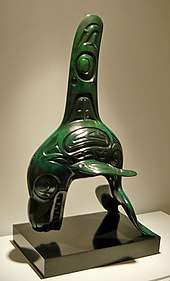
_and_whalers.jpeg)